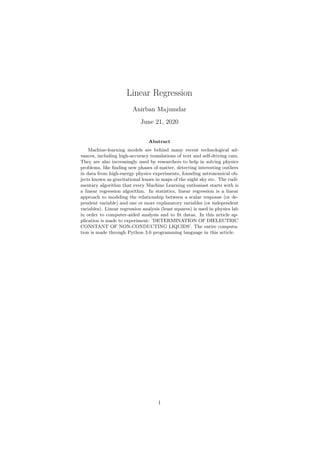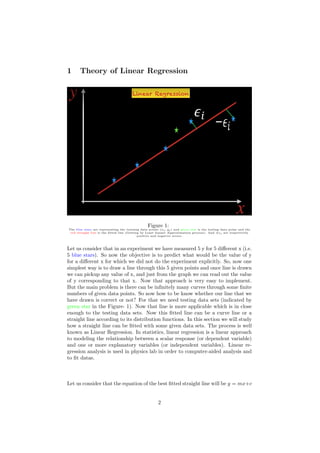This document discusses the application of linear regression in machine learning and its use in physics experiments, specifically to determine the dielectric constant of non-conducting liquids. It explains the mathematical basis of linear regression, the implementation through Python programming, and the methodology for measuring capacitance in a cylindrical capacitor setup. The conclusion emphasizes the importance of machine learning and linear regression as essential tools in physics research.




![Figure 2:
Dielectric measurement setup for non conducting liquids.
The capacitance per unit length of a long cylindrical capacitor immersed in
a medium of dielectric constant k is given by
C = k
2π 0
ln r2
r1
(Where 0 is free space permittivity, r1 is external radius of inner cylinder and r2 is internal radius of outer cylinder.)
In actual practice, there are errors due to stray capacitances (Cs) at the ends
of the cylinders and the leads. In any accurate measurement, it is necessary to
eliminate these. It has been done in the following way:
Consider a cylindrical capacitor of length L filled to a height h < L with a
liquid of dielectric constant k. Its total capacitance is given by-
C =
2π 0
ln r2
r1
[kh + 1 · (L − h)] + Cs
⇒ C =
2π 0
ln r2
r1
(k − 1) h +
2π 0L
ln r2
r1
+ Cs
So, the above equation shows that the measured capacity C is a linear function
of h (the height upto which the liquid is filled in the capacitor). If we vary the
liquid height h, and measure it, together with the corresponding capacitance C,
the plot of the data should be a straight line. The slope of this equation is given
by-
m =
2π 0
ln r2
r1
(k − 1)
⇒ k =
m ln r2
r1
2π 0
+ 1
From the above equation we can determine k for known values of r1 and r2.
5](https://image.slidesharecdn.com/linearregressiontheoryandprogrammingcodeinpython-200621151459/85/Linear-regression-Theory-and-Application-In-physics-point-of-view-using-python-programming-language-5-320.jpg)
![2.2 Experimental Results
Liquid Sample CCl4
External radius of inner cylinder 25.4mm
Internal radius of outer cylinder 30.6mm
Liquid Height (cm) Capacitance (pF)
0.0 0.70
1.0 4.54
2.0 8.48
3.0 11.98
4.0 15.95
5.0 19.78
6.0 23.88
7.0 28.07
2.3 Fitting of Datas Using basic Linear Regression Theory
Python Coding-
import matplotlib.pyplot as plt
import numpy as np
from math import *
X=np.array([0.0,1.0,2.0,3.0,4.0,5.0,6.0,7.0])
Y=np.array([0.7,4.54 ,8.48 ,11.98 ,15.95 ,19.78 ,23.88 ,28.07])
n=X.size
sop=0
x=0
y=0
x2=0
for i in range (n):
sop=sop+(X[i]*Y[i])
x=x+X[i]
y=y+Y[i]
x2=x2+(X[i]) ** 2
m=((n*sop)-(x*y))/float ((n*x2)-(x) ** 2)
c=((y)-(m*x))/float(n)
M=np.full(n,m)
C=np.full(n,c)
Y_avg=M*X+C
print("The equation of the fitted straight line is y=",m,"x+",c)
plt.plot(X,Y,’o’)
plt.plot(X, Y_avg , color=’red ’)
plt.xlabel(’Height (cm)’)
plt.ylabel(’Capacitance (pF)’)
plt.legend([’Data Plot ’, ’Fitted Plot ’])
plt.title(’Capacitance vs. Height Plot for CCl_4 ’)
plt.show ()
6](https://image.slidesharecdn.com/linearregressiontheoryandprogrammingcodeinpython-200621151459/85/Linear-regression-Theory-and-Application-In-physics-point-of-view-using-python-programming-language-6-320.jpg)
![The output is-
2.4 Fitting of Datas Using LinearRegression Python Pack-
age
Python Coding-
import matplotlib.pyplot as plt
import numpy as np
from sklearn. linear_model import LinearRegression
x=np.array([0.0,1.0,2.0,3.0,4.0,5.0,6.0,7.0])
y=np.array([0.7,4.54 ,8.48 ,11.98 ,15.95 ,19.78 ,23.88 ,28.07])
X=x.reshape(-1,1)
Y=y.reshape(-1,1)
reg= LinearRegression ()
reg.fit(X,Y)
Y_pred = reg.predict(X)
m=reg.coef_
c=reg.intercept_
print("The equation of the fitted straight line is y=",m[0,0],"x+",
c[0])
plt.plot(X,Y,’o’)
plt.plot(X, Y_pred , color=’red’)
plt.xlabel(’Height (cm)’)
plt.ylabel(’Capacitance (pF)’)
plt.legend([’Data Plot ’, ’Fitted Plot ’])
plt.title(’Capacitance vs. Height Plot for CCl_4 ’)
plt.show ()
7](https://image.slidesharecdn.com/linearregressiontheoryandprogrammingcodeinpython-200621151459/85/Linear-regression-Theory-and-Application-In-physics-point-of-view-using-python-programming-language-7-320.jpg)
